SteveR
Member
- Joined
- Sep 22, 2016
- Messages
- 1,010
A week ago we hiked to one of our favourite spots in the Spray Valley south of Canmore, Alberta- the Sparrowhawk Tarns. I'm pretty sure that I posted a report after our last visit there, but that was a few years ago, so here you go, again.
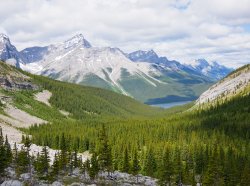
A good hiker made trail winds upwards from the shores of the Spray Lake reservoir, breaking out of the forest on the margin of a massive ancient rockslide.
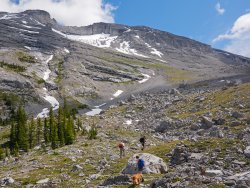
Meandering up the boulderfield.
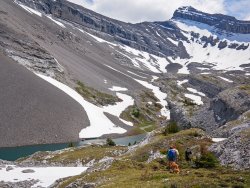
With the late snowmelt, the first tarn, which dries up to a mere puddle later in the summer, is still nearly full.
Apologies to Yvonne for all that snow- and there's more to come!
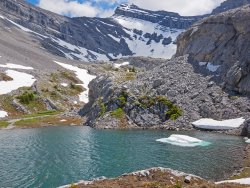
First tarn below the summit of Mount Bogart.
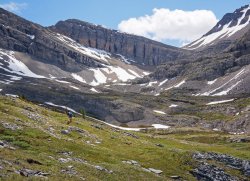
Onwards after lunch at the tarn. Our route will undulate across the terrain towards the cascades in the distance, then up beside them to a higher basin below the cliffs.
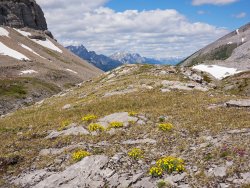
A look back.
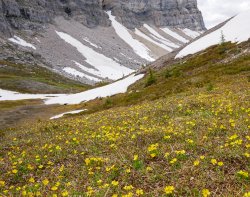
Buttercups in meadows still soggy from the melting snowbanks.
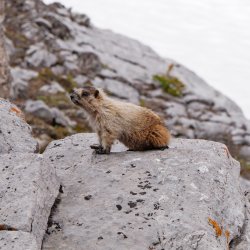
With the rocky terrain and abundant pockets of meadow- this valley is a marmot hotspot.
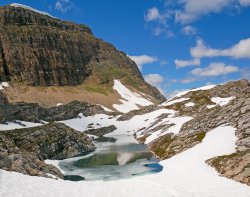
Tarn #2- Rockbound. My favourite.
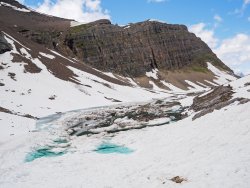
At the back of the basin, the largest tarn is still filled with avalanche debris. Usually by this time it might feature only a few remnant icebergs.
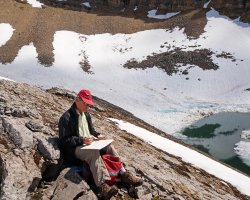
While Paul breaks out his compact watercolour kit for an hour spent painting, we wander around the rest of the tarns, several of which are still partly or fully frozen.
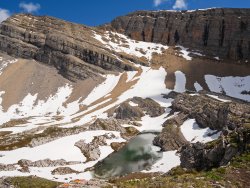
Another view of Rockbound Tarn.
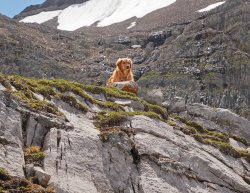
Meanwhile, Piper watches the marmots. Usually she is very well behaved and obedient while hiking off leash, but today the multitude of whistling rodents overwhelmed her training a time or two and the wolf instincts took over. No chance of her catching them at all though- there were simply too many nooks and crannies to retreat to.
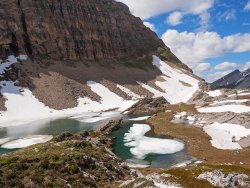
More tarns, as we are on the move again after Paul has his watercolor fleshed out, for completion at home.
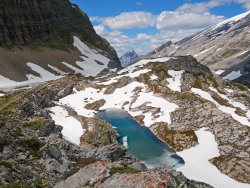
Rockbound, again. I told you it was my favourite!
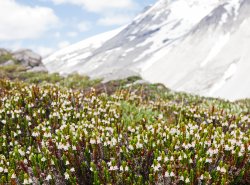
White Heather. Lots of the red variety here too, but still only budding.
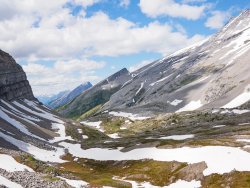
A look at our route out. We came in more along the right side of the basin.
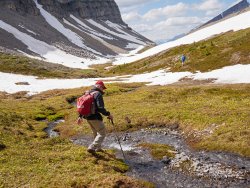
The meadow stream draining the upper tarns will vanish into the rockslide and limestone karst up ahead, before reappearing much lower down.
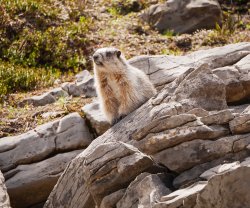
Yep, there were many more marmots.
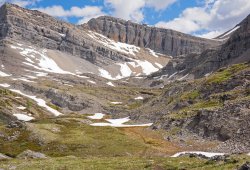
Looking back as we climb briefly out of the sunken basin holding the meadows. Where'd that stream go?
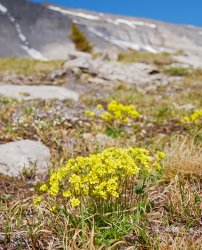
Yellow Draba below the ridge of Mount Sparrowhawk.
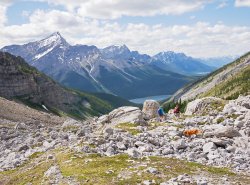
Back into the rockslide, where a trail is slowly being beaten in by hiker feet. We saw only about 6 others here today, despite the hordes at the official trailheads on the drive in. I suspect that the sometimes tedious route through the boulder field and the off trail rambling above keeps the crowds away. Let's hope it stays that way.
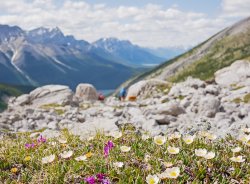
Avens and Sweetvetch- typical flora in the rocky limestone terrain of the Spray Valley.
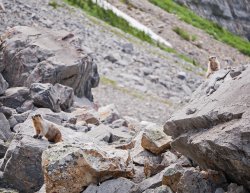
If the tarn area was a marmot village, the lower part of the boulderfield is a metropolis. It obviously is ideal habitat for them.
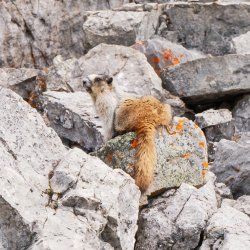
One final marmot shot. By now, Piper was on leash as all the sassy marmots were simply too much for her to take!
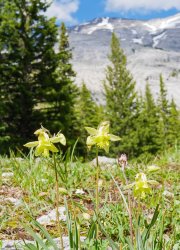
Columbine, as we reach the margin of the forest and the not overly interesting, but easy and pleasant trail down to roadside at Spray Lakes.

A good hiker made trail winds upwards from the shores of the Spray Lake reservoir, breaking out of the forest on the margin of a massive ancient rockslide.

Meandering up the boulderfield.

With the late snowmelt, the first tarn, which dries up to a mere puddle later in the summer, is still nearly full.
Apologies to Yvonne for all that snow- and there's more to come!

First tarn below the summit of Mount Bogart.

Onwards after lunch at the tarn. Our route will undulate across the terrain towards the cascades in the distance, then up beside them to a higher basin below the cliffs.

A look back.

Buttercups in meadows still soggy from the melting snowbanks.

With the rocky terrain and abundant pockets of meadow- this valley is a marmot hotspot.

Tarn #2- Rockbound. My favourite.

At the back of the basin, the largest tarn is still filled with avalanche debris. Usually by this time it might feature only a few remnant icebergs.

While Paul breaks out his compact watercolour kit for an hour spent painting, we wander around the rest of the tarns, several of which are still partly or fully frozen.

Another view of Rockbound Tarn.

Meanwhile, Piper watches the marmots. Usually she is very well behaved and obedient while hiking off leash, but today the multitude of whistling rodents overwhelmed her training a time or two and the wolf instincts took over. No chance of her catching them at all though- there were simply too many nooks and crannies to retreat to.

More tarns, as we are on the move again after Paul has his watercolor fleshed out, for completion at home.

Rockbound, again. I told you it was my favourite!

White Heather. Lots of the red variety here too, but still only budding.

A look at our route out. We came in more along the right side of the basin.

The meadow stream draining the upper tarns will vanish into the rockslide and limestone karst up ahead, before reappearing much lower down.

Yep, there were many more marmots.

Looking back as we climb briefly out of the sunken basin holding the meadows. Where'd that stream go?

Yellow Draba below the ridge of Mount Sparrowhawk.

Back into the rockslide, where a trail is slowly being beaten in by hiker feet. We saw only about 6 others here today, despite the hordes at the official trailheads on the drive in. I suspect that the sometimes tedious route through the boulder field and the off trail rambling above keeps the crowds away. Let's hope it stays that way.

Avens and Sweetvetch- typical flora in the rocky limestone terrain of the Spray Valley.

If the tarn area was a marmot village, the lower part of the boulderfield is a metropolis. It obviously is ideal habitat for them.

One final marmot shot. By now, Piper was on leash as all the sassy marmots were simply too much for her to take!

Columbine, as we reach the margin of the forest and the not overly interesting, but easy and pleasant trail down to roadside at Spray Lakes.
